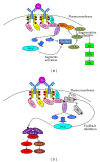Does B cell receptor signaling in chronic lymphocytic leukaemia cells differ from that in other B cell types?
- PMID: 25101192
- PMCID: PMC4102070
- DOI: 10.1155/2014/208928
Does B cell receptor signaling in chronic lymphocytic leukaemia cells differ from that in other B cell types?
Abstract
Chronic lymphocytic leukaemia (CLL) is an incurable malignancy of mature B cells. CLL is important clinically in Western countries because of its commonality and because of the significant morbidity and mortality associated with the progressive form of this incurable disease. The B cell receptor (BCR) expressed on the malignant cells in CLL contributes to disease pathogenesis by providing signals for survival and proliferation, and the signal transduction pathway initiated by engagement of this receptor is now the target of several therapeutic strategies. The purpose of this review is to outline current understanding of the BCR signal cascade in normal B cells and then question whether this understanding applies to CLL cells. In particular, this review studies the phenomenon of anergy in CLL cells, and whether certain adaptations allow the cells to overcome anergy and allow full BCR signaling to take place. Finally, this review analyzes how BCR signals can be therapeutically targeted for the treatment of CLL.
Figures




Similar articles
-
BCR signaling in chronic lymphocytic leukemia and related inhibitors currently in clinical studies.Int Rev Immunol. 2013 Aug;32(4):358-76. doi: 10.3109/08830185.2013.786711. Epub 2013 Apr 25. Int Rev Immunol. 2013. PMID: 23617253 Review.
-
Recent advances in the pathogenesis and treatment of chronic lymphocytic leukemia.Pril (Makedon Akad Nauk Umet Odd Med Nauki). 2014;35(3):105-20. doi: 10.1515/prilozi-2015-0015. Pril (Makedon Akad Nauk Umet Odd Med Nauki). 2014. PMID: 25725699 Review.
-
The lymph node microenvironment promotes B-cell receptor signaling, NF-kappaB activation, and tumor proliferation in chronic lymphocytic leukemia.Blood. 2011 Jan 13;117(2):563-74. doi: 10.1182/blood-2010-05-284984. Epub 2010 Oct 12. Blood. 2011. PMID: 20940416 Free PMC article. Clinical Trial.
-
Aspartic Aminopeptidase Is a Novel Biomarker of Aggressive Chronic Lymphocytic Leukemia.Cancers (Basel). 2020 Jul 12;12(7):1876. doi: 10.3390/cancers12071876. Cancers (Basel). 2020. PMID: 32664705 Free PMC article.
-
Pro-apoptotic TP53 homolog TAp63 is repressed via epigenetic silencing and B-cell receptor signalling in chronic lymphocytic leukaemia.Br J Haematol. 2013 Dec;163(5):590-602. doi: 10.1111/bjh.12580. Epub 2013 Sep 30. Br J Haematol. 2013. PMID: 24117128 Free PMC article.
Cited by
-
Proliferative Signals in Chronic Lymphocytic Leukemia; What Are We Missing?Front Oncol. 2020 Oct 8;10:592205. doi: 10.3389/fonc.2020.592205. eCollection 2020. Front Oncol. 2020. PMID: 33134182 Free PMC article. Review.
-
The Role of Methylation in Chronic Lymphocytic Leukemia and Its Prognostic and Therapeutic Impacts in the Disease: A Systematic Review.Adv Hematol. 2024 Feb 23;2024:1370364. doi: 10.1155/2024/1370364. eCollection 2024. Adv Hematol. 2024. PMID: 38435839 Free PMC article. Review.
-
PKCβ Facilitates Leukemogenesis in Chronic Lymphocytic Leukaemia by Promoting Constitutive BCR-Mediated Signalling.Cancers (Basel). 2022 Dec 6;14(23):6006. doi: 10.3390/cancers14236006. Cancers (Basel). 2022. PMID: 36497487 Free PMC article.
-
Insights into genetic aberrations and signalling pathway interactions in chronic lymphocytic leukemia: from pathogenesis to treatment strategies.Biomark Res. 2024 Dec 28;12(1):162. doi: 10.1186/s40364-024-00710-w. Biomark Res. 2024. PMID: 39732734 Free PMC article. Review.
-
LINC00152 expression in normal and Chronic Lymphocytic Leukemia B cells.Hematol Oncol. 2022 Feb;40(1):40-47. doi: 10.1002/hon.2938. Epub 2021 Oct 28. Hematol Oncol. 2022. PMID: 34679195 Free PMC article.
References
Publication types
LinkOut - more resources
Full Text Sources
Other Literature Sources

